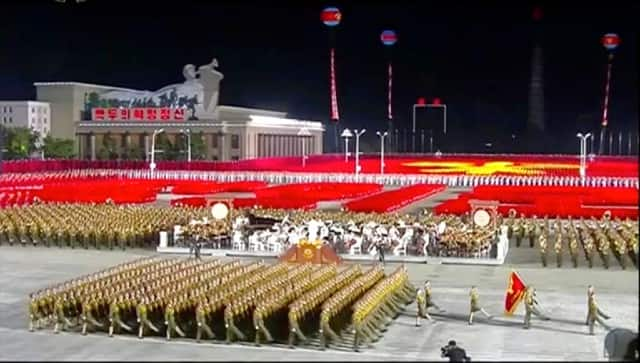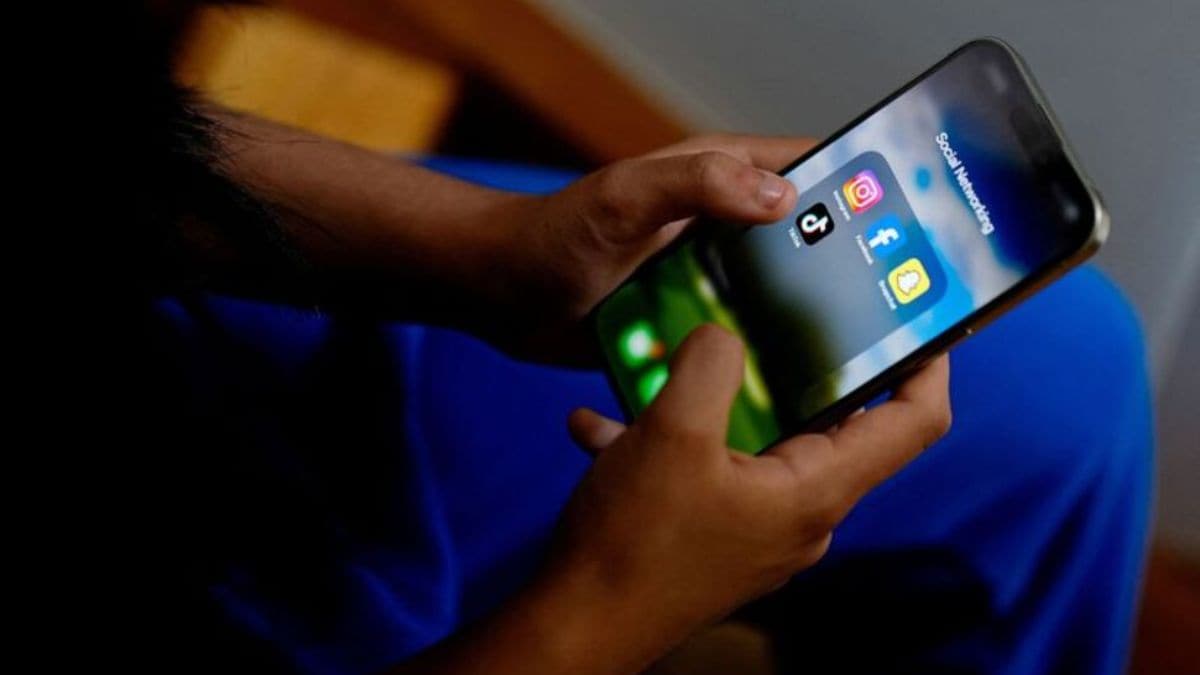Seoul: North Korea displayed what appeared to be its largest-ever intercontinental ballistic missile during a nighttime military parade in Pyongyang on Saturday, but it was not immediately clear if the missile would work or was for show. The North’s leader, Kim Jong-un, has vowed to strengthen the country’s nuclear deterrent amid stalled diplomacy with US president Donald Trump, coming at a time when he has struggled to keep his promises to strengthen the hermetic country’s economy. The new ICBM appeared to be much larger than North Korea’s largest, previously disclosed long-range missile, the Hwasong-15. The size of the new missile indicated that it might be able to fly farther and carry a more powerful nuclear warhead, South Korean, and other analysts said, although it has never been flight-tested. North Korea has been increasing its missile and nuclear technologies despite Trump’s on-again, off-again diplomacy with Kim, and the display Saturday is likely an attempt to show that more advances are being made. But it was not immediately clear if the new missiles were real or were mocked-up versions. When North Korea test-launched the Hwasong-15 in late 2017, it claimed the missile could reach any part of the continental United States carrying a nuclear warhead. Although North Korea has conducted three ICBM tests, all in 2017, it remained unclear whether the country had the technology needed to protect a nuclear warhead during atmospheric reentry and deliver the weapon to its target. During the parade Saturday, Hwasong-15 missiles were carried on nine-axle vehicles. But the new ICBMs were rolled out on 11-axle vehicles. “We will continue to strengthen the war deterrent, the righteous self-defense means,” against nuclear and other threats from “hostile forces,” Kim said during a speech at the military parade, without citing the United States by name. Kim said his country has expanded its military force “at a speed and in a quantity and quality we have wanted.” [caption id=“attachment_8901481” align=“alignnone” width=“640”] North Korean leader Kim Jong-un (centre) smiles as he leaves a ceremony to celebrate the 75th anniversary of the country’s ruling party in Pyongyang. AP[/caption] North Korea had been preparing for months for the military parade Saturday, the 75th anniversary of its ruling Workers’ Party. The “special” celebration Kim had promised turned out to be a rare nighttime military parade in a plaza in Pyongyang named after his grandfather and North Korea’s founder, Kim Il Sung. The parade featured fireworks and military planes firing flares in the night sky while columns of goose-stepping soldiers marched down the plaza, swearing to “defend Kim Jong-un with our lives". But the real highlight was an impressive array of artillery pieces, tanks, rockets, and missiles. Analysts noted Kim’s political calculations in deciding how to celebrate the party anniversary, an important national holiday, which comes just weeks before the November election in the United States. By displaying a new and apparently more powerful ICBM, Kim seemed to demonstrate the North’s growing military threat to whoever wins the election. But he also was hedging his bets over what both he and Trump have called their special “personal relationship”; at one point, Trump said he “fell in love” with the North Korean dictator. Kim declared a halt to all nuclear and ICBM tests before his first summit meeting with Trump, in Singapore in June 2018. Trump has called the moratorium one of his biggest foreign policy achievements, insisting that his diplomacy has reduced the risk of war with the North. By showing off — but not going so far as launching — a new ICBM for the party anniversary, analysts said Kim appeared to want to avoid provoking Trump unnecessarily before the US election. But the display may indicate that he has the ability to test-launch the missile if he decided to try to boost his leverage in future talks with whoever wins the election. Kim’s government, hobbled by floods and a drop in trade because of COVID-19 as well as years of United Nations sanctions, has had little to show his people to fulfill his promise to build a strong economy. So the parade was seen as a way to boost his people’s morale by showcasing his biggest achievement as their leader: a drastic increase in the North’s arsenal of nuclear warheads and the missiles to deliver those weapons. “The Kim regime is focused on domestic challenges and is waiting out the US presidential election before starting another cycle of provocations and diplomacy,” said Leif-Eric Easley, a professor of international studies at Ewha Womans University in Seoul, South Korea. “Parading a ‘new strategic weapon’ offers domestic political benefits without the risks of an internationally provocative missile test.” Kim became the first North Korean leader to meet a sitting US president when he held his first summit with Trump in Singapore and agreed to “work toward complete denuclearisation of the Korean Peninsula". [caption id=“attachment_8901491” align=“alignnone” width=“640”]
 In this image made from video broadcasted by North Korea’s KRT on 10 October, 2020, military parade is held during a ceremony to celebrate the 75th anniversary of the country’s ruling party in Pyongyang. AP[/caption] But his second meeting with Trump, held in Vietnam in February 2019, collapsed without an agreement on how soon North Korea should dismantle its nuclear arsenal and when Washington should ease crippling sanctions imposed on the country. In his 2020 New Year’s message, a defiant Kim said his country no longer felt bound by its self-declared nuclear and ICBM test moratorium and vowed to show the world a “new strategic weapon". But until the military parade Saturday, no display of such a weapon materialised, as North Korea seemed preoccupied with fighting COVID-19 and extensive flood damage. During his speech, Kim reiterated his claim that the country had no cases of COVID-19, and a large, maskless crowd gathered for the parade. Outside experts are skeptical about the claim, given the country’s poor public health system. Harry Kazianis, senior director of Korean studies at the Washington-based Center for the National Interest, said that the new ICBM seems to be a derivative of the Hwasong-15. But it is “much bigger and clearly more powerful than anything” in the North Korean arsenal, indicating that it could carry a larger and deadlier nuclear payload, potentially even multiple warheads, to potential targets like US cities, he said. “Despite North Korea being hammered this year by three typhoons, constant food insecurity issues, international sanctions and now threats from COVID-19, the Kim regime has shown the world once again its long-range missile programme will continue to advance with each passing day,” Kazianis wrote in an email. The parade Saturday also reminded the outside world of how mobile ballistic missiles have become a key component of North Korea’s military strategy. Since becoming the North Korean leader nearly a decade ago, Kim has focused on developing and testing such weapons, which can be easily hidden in the country’s mountainous terrain and numerous underground tunnels. In recent years, his military has also tested ballistic missiles using solid fuel, which have the advantage of being able to stay in a ready-to-strike state and are considered harder to detect and destroy. Those solid-fuel missiles were on display in the military parade Saturday. Choe Sang-Hun c.2020 The New York Times Company
In this image made from video broadcasted by North Korea’s KRT on 10 October, 2020, military parade is held during a ceremony to celebrate the 75th anniversary of the country’s ruling party in Pyongyang. AP[/caption] But his second meeting with Trump, held in Vietnam in February 2019, collapsed without an agreement on how soon North Korea should dismantle its nuclear arsenal and when Washington should ease crippling sanctions imposed on the country. In his 2020 New Year’s message, a defiant Kim said his country no longer felt bound by its self-declared nuclear and ICBM test moratorium and vowed to show the world a “new strategic weapon". But until the military parade Saturday, no display of such a weapon materialised, as North Korea seemed preoccupied with fighting COVID-19 and extensive flood damage. During his speech, Kim reiterated his claim that the country had no cases of COVID-19, and a large, maskless crowd gathered for the parade. Outside experts are skeptical about the claim, given the country’s poor public health system. Harry Kazianis, senior director of Korean studies at the Washington-based Center for the National Interest, said that the new ICBM seems to be a derivative of the Hwasong-15. But it is “much bigger and clearly more powerful than anything” in the North Korean arsenal, indicating that it could carry a larger and deadlier nuclear payload, potentially even multiple warheads, to potential targets like US cities, he said. “Despite North Korea being hammered this year by three typhoons, constant food insecurity issues, international sanctions and now threats from COVID-19, the Kim regime has shown the world once again its long-range missile programme will continue to advance with each passing day,” Kazianis wrote in an email. The parade Saturday also reminded the outside world of how mobile ballistic missiles have become a key component of North Korea’s military strategy. Since becoming the North Korean leader nearly a decade ago, Kim has focused on developing and testing such weapons, which can be easily hidden in the country’s mountainous terrain and numerous underground tunnels. In recent years, his military has also tested ballistic missiles using solid fuel, which have the advantage of being able to stay in a ready-to-strike state and are considered harder to detect and destroy. Those solid-fuel missiles were on display in the military parade Saturday. Choe Sang-Hun c.2020 The New York Times Company
The size of the new missile indicated that it might be able to fly farther and carry a more powerful nuclear warhead, South Korean, and other analysts said, although it has never been flight-tested
Advertisement
End of Article


)

)
)
)
)
)
)
)
)



